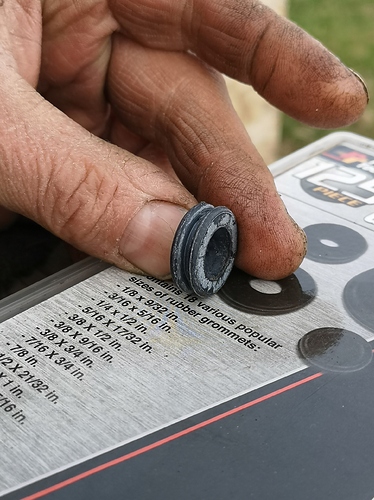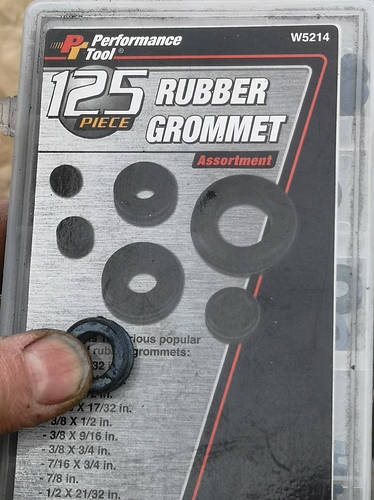Sounds interesting…
The video link doesn’t work.
Try again, I fixed it!
Excellent solution!
That should make things a lot easier.
Hi Thierry,
Thanks for sharing the idea and video, but I don’t understand what I’m looking at. How about a sketch? I can imagine a hinge fastened to the diaphragm, but don’t understand how you are sealing the output rod.
Excuse me time for the answer, I am very busy at this time of the year
Bruse here is what I use to seal
Another advantage of this automixer design is that it can also work horizontally
Thank you for taking the time to answer. Very Clever.
Hello everyone
I would like to replace my big 5 "cyclone with two small cyclones in parallel.
Or can I find the information to size cyclones of equivalent efficiency?
Thank , Thierry
I think l used 2 4" cyclones on my mb, worked well. Oh, that was paralell!
Dyson uses a huge array of smaller cyclones in their vacuums. They take their engineering pretty seriously so I don’t think the cyclone arrangement is an accident.
The motivation could be more compact packaging but I think it has more to do with smaller cyclones having higher accelerations to help with separation efficiency. Now that I think about it… I’m sure there is plenty of academic literature on the subject.
Sounds interesting. Hoping to see more info about Dyson projects.
I think the Dyson design is efficient enough to remove smoke from air, but the bottom line is it does so with a major consumption of power. In a gasifier system that will amount to a big pressure drop, which will rob significantly from engine power. With a super charger that could be overcome.
But, in engineering there’s such a thing as “too good”, and I suspect this is one example. Max has described a sound system utilizing reheating and a final paper filter to minimize pressure drops.
Steve has theorized that turbulence causes CO to revert to carbon black. A Dyson would certainly put that to the test…
Well, they seems to be closed on perfecting it. Removing the smoke from air is a huge step already.
I use a Dyson cyclone canister with my inline filter pipe before the engine just to see what can be stopped from going into the engine and i have some very fine soot/charcoal fines in the bottom .it was a pain to make it air tight as my engine does not have the suction needed to complete the sealing between the container and the cyclones , so in the end i used silicon over every joint
Hi Garry
I am thinking of replacing my 5 "cyclone with 3 3 "cyclones in order to improve gas filtration without increasing the pressure drop of the system.
Is it a bad idea? 
The cyclones would be downstream of an oil bath filter and a safety filter
I’m far from an engineer, but it sounds like you are probably on the right track.
I guess the proof will be to try to verify, and report back to the group.
Dave,
Please remind me. What are you using for a filter before the Dyson cyclone?
I have the gas outlet on top of the 55 gallon drum from there it goes to a fire extinguisher cyclone and then into a 8 inch dia pipe that is about 3ft tall filled with lambs wool and foam filters and then onto a small inline pool filter and or the Dyson filter before the engine .
Hello Trigaux,
The cyclone’s sides slow down the particulate matter by
gravity/friction and that matter spirals down to a removable/ cleanable
collection reservoir at the bottom (as the gas is exited at the top of the cyclone).
Mine is a 1 1/2" screw top 2 quart metal container that screws onto the bottom
of the threaded cyclone. I built to the specs for a 35 HP engine on the imbert chart.
The thing works great removing huge amounts of particulate matter and gives me clean
burning gas. It takes up some space, but you’re looking for quality clean gas, right.
OK, that’s one vote for the single larger cyclone. Checkout “My first small engine run”
in the Small engine section for my cyclone.
Dave,
Cyclone followed by lambs wool and foam filters sounds great. Do you have any observations or opinions about how much wool, what kind of foam and what order you think works best? Are there ever any moisture issues?
We on DOW are so blessed to learn from your experience with so many hours of real world useful work from gasifiers.
Bruce ,
I bought 3 pieces of wool 20 inches by 40 and 3 inch’s thick that someone was advertising as insulation its like carded lambs wool its really fine and so i just stuff as much into the tube to make it as hard as possible for larger particles to get past and then a 4 inch open cell foam circle on top , i do it in that order mainly to stop any loose strands of wool being sucked further up stream .
Moisture is something i don’t seem to be able to control with how i have my setup due to many factors , we have a humidity of 97% today and so i guess my charcoal will soak a fair amount of that up and give me wet filters at the end of the day , other times its bone dry , living in the clouds can be fun .
I forgot to close the air valve on the gasifier after cleaning out the build up around the nozzle the other day and so my drum full of charcoal was popping away when i lit it yesterday ,and what i noticed was a very weak lack luster flame when flaring off , but if i stopped the fan and allowed it to just sit for a few mins as soon as i started the fan i got a roaring blue flame and i do mean roaring for about a 40 seconds and then back to a lack luster type of flame , that continued for about 10 mins till all of a sudden a good roaring flare stayed on , i guess my then i had managed to dry out most the charcoal in my drum .

